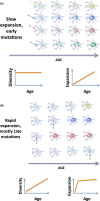When man got his mtDNA deletions?
- PMID: 24894296
- PMCID: PMC4326951
- DOI: 10.1111/acel.12231
When man got his mtDNA deletions?
Abstract
Somatic mtDNA mutations and deletions in particular are known to clonally expand within cells, eventually reaching detrimental intracellular concentrations. The possibility that clonal expansion is a slow process taking a lifetime had prompted an idea that founder mutations of mutant clones that cause mitochondrial dysfunction in the aged tissue might have originated early in life. If, conversely, expansion was fast, founder mutations should predominantly originate later in life. This distinction is important: indeed, from which mutations should we protect ourselves - those of early development/childhood or those happening at old age? Recently, high-resolution data describing the distribution of mtDNA deletions have been obtained using a novel, highly efficient method (Taylor et al., ). These data have been interpreted as supporting predominantly early origin of founder mutations. Re-analysis of the data implies that the data actually better fit mostly late origin of founders, although more research is clearly needed to resolve the controversy.
© 2014 The Authors. Aging Cell published by the Anatomical Society and John Wiley & Sons Ltd.
Figures


Comment in
-
Response to: 'when man got his mtDNA deletions?'.Aging Cell. 2014 Aug;13(4):583. doi: 10.1111/acel.12230. Epub 2014 Jun 4. Aging Cell. 2014. PMID: 24894130 Free PMC article. No abstract available.
Comment on
-
Targeted enrichment and high-resolution digital profiling of mitochondrial DNA deletions in human brain.Aging Cell. 2014 Feb;13(1):29-38. doi: 10.1111/acel.12146. Epub 2013 Sep 11. Aging Cell. 2014. PMID: 23911137 Free PMC article.
Similar articles
-
Response to: 'when man got his mtDNA deletions?'.Aging Cell. 2014 Aug;13(4):583. doi: 10.1111/acel.12230. Epub 2014 Jun 4. Aging Cell. 2014. PMID: 24894130 Free PMC article. No abstract available.
-
On the timing and the extent of clonal expansion of mtDNA deletions: evidence from single-molecule PCR.Exp Neurol. 2009 Aug;218(2):316-9. doi: 10.1016/j.expneurol.2009.04.029. Epub 2009 May 6. Exp Neurol. 2009. PMID: 19426731 Free PMC article.
-
Targeted enrichment and high-resolution digital profiling of mitochondrial DNA deletions in human brain.Aging Cell. 2014 Feb;13(1):29-38. doi: 10.1111/acel.12146. Epub 2013 Sep 11. Aging Cell. 2014. PMID: 23911137 Free PMC article.
-
Mitochondrial DNA alterations as ageing-associated molecular events.Mutat Res. 1992 Sep;275(3-6):145-55. doi: 10.1016/0921-8734(92)90019-l. Mutat Res. 1992. PMID: 1383757 Review.
-
Clonal expansion of mitochondrial DNA deletions and the progression of multiple sclerosis.CNS Neurol Disord Drug Targets. 2012 Aug;11(5):589-97. doi: 10.2174/187152712801661194. CNS Neurol Disord Drug Targets. 2012. PMID: 22583438 Review.
Cited by
-
Hypothesis and Theory: Characterizing Abnormalities of Energy Metabolism Using a Cellular Platform as a Personalized Medicine Approach for Alzheimer's Disease.Front Cell Dev Biol. 2021 Jul 30;9:697578. doi: 10.3389/fcell.2021.697578. eCollection 2021. Front Cell Dev Biol. 2021. PMID: 34395428 Free PMC article.
-
Secondary structure of the human mitochondrial genome affects formation of deletions.BMC Biol. 2023 May 8;21(1):103. doi: 10.1186/s12915-023-01606-1. BMC Biol. 2023. PMID: 37158879 Free PMC article.
-
Resolving the Enigma of the Clonal Expansion of mtDNA Deletions.Genes (Basel). 2018 Feb 27;9(3):126. doi: 10.3390/genes9030126. Genes (Basel). 2018. PMID: 29495484 Free PMC article.
-
Germline and somatic mtDNA mutations in mouse aging.PLoS One. 2018 Jul 24;13(7):e0201304. doi: 10.1371/journal.pone.0201304. eCollection 2018. PLoS One. 2018. PMID: 30040856 Free PMC article.
-
Role of the mitochondrial DNA replication machinery in mitochondrial DNA mutagenesis, aging and age-related diseases.Ageing Res Rev. 2017 Jan;33:89-104. doi: 10.1016/j.arr.2016.04.006. Epub 2016 Apr 30. Ageing Res Rev. 2017. PMID: 27143693 Free PMC article. Review.
References
-
- Khrapko K, Nekhaeva E, Kraytsberg Y, Kunz W. Clonal expansions of mitochondrial genomes: implications for in vivo mutational spectra. Mutat. Res. 2003;522:13–19. - PubMed
-
- Korr H, Kurz C, Seidler TO, Sommer D, Schmitz C. Mitochondrial DNA synthesis studied autoradiographically in various cell types in vivo. Braz. J. Med. Biol. Res. 1998;31:289–298. - PubMed
Publication types
MeSH terms
Substances
LinkOut - more resources
Full Text Sources
Other Literature Sources

